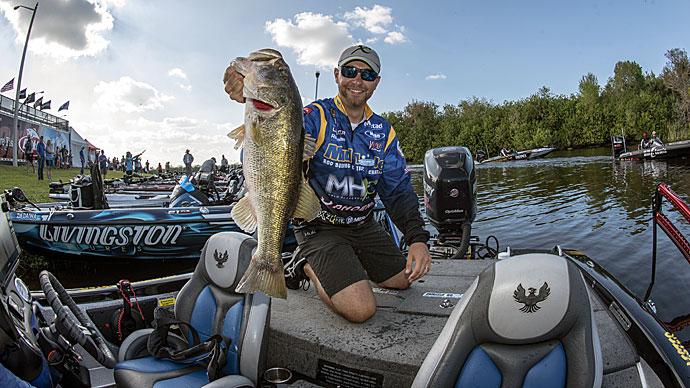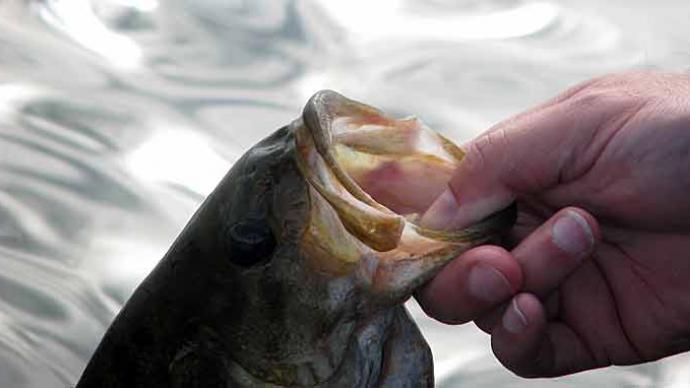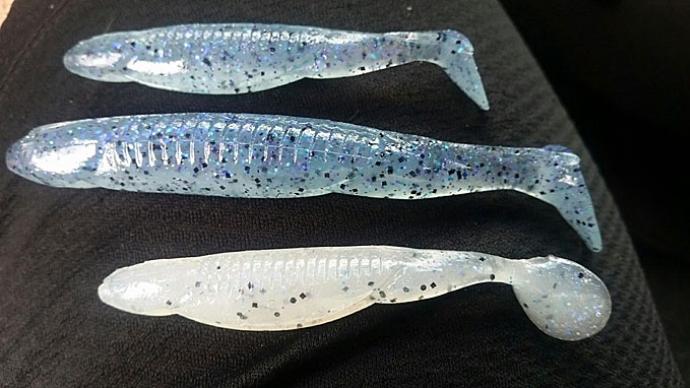
Hungry postspawn bass can gulp down a quick and easy breakfast when the shad spawn is on.
Former Bassmaster Classic and FLW Forrest Wood Cup champion Dion Hibdon takes advantage of the shad spawn several times a year to catch bass on Ozark lakes. He targets bass hanging around spawning shad in the late spring and fall on the waters in his area, but he has been told by former Bassmaster Elite Series pro Kenyon Hill that shad on some lakes in warmer climates can spawn as often as four times a year. Hill is the son of the late famed Oklahoma fisheries academic Loren Hill, who researched bass and their prey.
Hibdon notes that the same factors that trigger the bass spawn also activate the shad spawn. “It normally starts when the water temperature gets into the high 60s or that neighborhood, and the moon (phase) absolutely has an effect on it,” Hibdon says.
The touring pro has found blueback herring spawning around clumps of islands and along clay banks, whereas threadfin and gizzard shad prefer different spawning banks. "On the Ozarks lakes, the shad get up around the rocks, and on other lakes around the country, they get around bushes and whatever kind of cover is in the lake," Hibdon says. "The threadfin and gizzard shad spawning in the same spot is a cool deal because you have two completely different sizes (of baitfish) for fishing big swimbaits or glide baits sizes (for gizzard shad), and then you can fish Rat-L-Trap size stuff (for threadfin).“
Shad spawning along the bank becomes a buffet line for bass. “It throws all the shad into certain areas,” Hibdon says. “It puts all the food up on the bank where the shad are easier for bass to catch. A bass' instinct is always to push its food shallow because it has the surface and bottom working for it, and when you get the surface and bottom close together, it is easier for the bass to catch the shad.”
Timing is critical when fishing the shad spawn because the baitfish prefer mating in low-light conditions. Hibdon suggests the best time to fish the shad spawn is from predawn dark to the first few hours of daylight. “If you get cloud cover or a rainy day, that can prolong it," Hibdon says. He notices the baitfish will also resume their spawning ritual in the evenings, usually during the last hour and a half of daylight.
Wind will have some effect on where the shad spawn. “Too much wind is not good for the shad spawn, but a little bit of breeze is perfect,” Hibdon says. “You don’t want the bank getting hammered by the wind.”
Fluctuating lake levels can also affect the shad spawn. Hibdon notices that shad seem to prefer spawning on a rising lake level rather than when the lake level is dropping. "If the water is going down, it throws the bass and the shad off,” Hibdon says. “The shad are up there in inches of water, and if you take away a couple of inches, then they are up there rubbing their bellies (on the bottom) and touching stuff which I am a big believer that they don't like touching stuff."

Any lure closely resembling a shad will produce bass during the shad spawn. Hibdon favors topwater lures such as poppers, Zara Spooks, or other walking-style baits. He also throws swimbaits and spinnerbaits when bass chow at the shad buffet. The Missouri pro also suggests throwing a white swim jig around flooded bushes when the shad spawn.
Twitching his topwater lures quickly and steadily usually produces strikes for Hibdon when the shad spawn is on. "I am keeping it moving most of the time," he says. "I am not doing much hesitating because the shad are non-stop swimming. I do like to watch and see what the shad are doing. If they are poking along down the bank, then I slow it down slightly." A sexy shad hue is Hibdon's favorite color for his topwaters to imitate the baitfish spawners.
Hibdon throws a 6.8- or 7.8-inch pro blue-red pearl Keitech swimbait on a 3/8- or 1/2-ounce swimbait jighead into the line of spawning shad in the shallows around docks, bushes, or rocks. He employs a quick retrieve to trigger strikes from bass attacking the vulnerable baitfish.
Running a tandem willowleaf spinnerbait at a rapid clip just below the surface produces bass for Hibdon during the shad spawn. He matches the color of the spawning shad by selecting a blade bait with silver spinners and a skirt mixed with white, gray, and chartreuse hues.
Most of the time, Hibdon matches his lures to the size of the spawning shad, but sometimes he brightens the colors of his lures. “If I feel like bass are starting to get off of the bait or quit biting it a little bit, I might put a bit more chartreuse to it or something like that,” Hibdon says. “For the most part, though, if the bait looks like shad, bass are going to eat it.”
Hibdon notices the shad spawn is short-lived, usually lasting only a week or a week and a half.
When word gets out that the shad spawn is on, get on your favorite lake before sunrise to take advantage of bass feasting at the baitfish buffet line.




